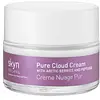What's inside
What's inside
 Key Ingredients
Key Ingredients

 Benefits
Benefits

 Concerns
Concerns

 Ingredients Side-by-side
Ingredients Side-by-side

Colloidal Oatmeal 0.5%
AbsorbentWater
Skin ConditioningStearic Acid
CleansingGlycerin
HumectantC12-15 Alkyl Benzoate
AntimicrobialCaprylic/Capric Triglyceride
MaskingGlyceryl Stearate Se
EmulsifyingGlyceryl Stearate
EmollientCetearyl Alcohol
EmollientDimethicone
EmollientSqualane
EmollientButyrospermum Parkii Butter
Skin ConditioningPhenoxyethanol
PreservativeCaprylyl Glycol
EmollientXanthan Gum
EmulsifyingAllantoin
Skin ConditioningSodium Hydroxide
BufferingTetrasodium EDTA
Chrysanthemum Parthenium Extract
Skin ConditioningCamellia Sinensis Leaf Extract
AntimicrobialGlycyrrhiza Glabra Root Extract
BleachingCeramide NP
Skin ConditioningEucalyptus Globulus Leaf Oil
PerfumingColloidal Oatmeal 0.5%, Water, Stearic Acid, Glycerin, C12-15 Alkyl Benzoate, Caprylic/Capric Triglyceride, Glyceryl Stearate Se, Glyceryl Stearate, Cetearyl Alcohol, Dimethicone, Squalane, Butyrospermum Parkii Butter, Phenoxyethanol, Caprylyl Glycol, Xanthan Gum, Allantoin, Sodium Hydroxide, Tetrasodium EDTA, Chrysanthemum Parthenium Extract, Camellia Sinensis Leaf Extract, Glycyrrhiza Glabra Root Extract, Ceramide NP, Eucalyptus Globulus Leaf Oil
Water
Skin ConditioningHydrogenated Didecene
Skin ConditioningButylene Glycol
HumectantGlyceryl Stearate
EmollientBisabolol
MaskingPrunus Amygdalus Dulcis Oil
Skin ConditioningSodium Hyaluronate
HumectantHydrolyzed Rice Protein
Skin ConditioningAngelica Archangelica Root Water
Skin ConditioningAcetyl Dipeptide-1 Cetyl Ester
Skin ConditioningLeuconostoc/Radish Root Ferment Filtrate
AntimicrobialCamellia Oleifera Leaf Extract
AstringentGlycerin
HumectantGlyceryl Caprylate
EmollientRubus Chamaemorus Seed Oil
Skin ConditioningSimmondsia Chinensis Seed Oil
EmollientAcrylates/C10-30 Alkyl Acrylate Crosspolymer
Emulsion StabilisingCanola Oil
EmollientCetyl Alcohol
EmollientCetyl Ricinoleate
EmollientSorbitan Stearate
EmulsifyingStearic Acid
CleansingCitrus Grandis Peel Oil
MaskingTriceteareth-4 Phosphate
EmulsifyingSilica
AbrasiveZea Mays Starch
AbsorbentGlyceryl Undecylenate
EmollientLaureth-3
EmulsifyingSodium Hydroxide
BufferingAloe Barbadensis Leaf Juice
Skin ConditioningHydroxyethylcellulose
Emulsion StabilisingPerfluorodecalin
Skin ConditioningPotassium Sorbate
PreservativeSodium Polyacrylate
AbsorbentEthylhexyl Stearate
EmollientSodium Benzoate
MaskingBuddleja Davidii Extract
Skin ConditioningGlycosphingolipids
EmollientSucrose Palmitate
EmollientThymus Vulgaris Flower/Leaf Extract
MaskingTrideceth-6
EmulsifyingXanthan Gum
EmulsifyingBiotin
AntiseborrhoeicWater, Hydrogenated Didecene, Butylene Glycol, Glyceryl Stearate, Bisabolol, Prunus Amygdalus Dulcis Oil, Sodium Hyaluronate, Hydrolyzed Rice Protein, Angelica Archangelica Root Water, Acetyl Dipeptide-1 Cetyl Ester, Leuconostoc/Radish Root Ferment Filtrate, Camellia Oleifera Leaf Extract, Glycerin, Glyceryl Caprylate, Rubus Chamaemorus Seed Oil, Simmondsia Chinensis Seed Oil, Acrylates/C10-30 Alkyl Acrylate Crosspolymer, Canola Oil, Cetyl Alcohol, Cetyl Ricinoleate, Sorbitan Stearate, Stearic Acid, Citrus Grandis Peel Oil, Triceteareth-4 Phosphate, Silica, Zea Mays Starch, Glyceryl Undecylenate, Laureth-3, Sodium Hydroxide, Aloe Barbadensis Leaf Juice, Hydroxyethylcellulose, Perfluorodecalin, Potassium Sorbate, Sodium Polyacrylate, Ethylhexyl Stearate, Sodium Benzoate, Buddleja Davidii Extract, Glycosphingolipids, Sucrose Palmitate, Thymus Vulgaris Flower/Leaf Extract, Trideceth-6, Xanthan Gum, Biotin
 Reviews
Reviews

Ingredients Explained
These ingredients are found in both products.
Ingredients higher up in an ingredient list are typically present in a larger amount.
Glycerin is already naturally found in your skin. It helps moisturize and protect your skin.
A study from 2016 found glycerin to be more effective as a humectant than AHAs and hyaluronic acid.
As a humectant, it helps the skin stay hydrated by pulling moisture to your skin. The low molecular weight of glycerin allows it to pull moisture into the deeper layers of your skin.
Hydrated skin improves your skin barrier; Your skin barrier helps protect against irritants and bacteria.
Glycerin has also been found to have antimicrobial and antiviral properties. Due to these properties, glycerin is often used in wound and burn treatments.
In cosmetics, glycerin is usually derived from plants such as soybean or palm. However, it can also be sourced from animals, such as tallow or animal fat.
This ingredient is organic, colorless, odorless, and non-toxic.
Glycerin is the name for this ingredient in American English. British English uses Glycerol/Glycerine.
Learn more about GlycerinGlyceryl Stearate is a mix of glycerin and stearic acid.
It is used to stabilize the mixing of water and oil ingredients. By preventing these ingredients from separating, it can help elongate shelf life. It can also help thicken the product's texture.
As an emollient, it helps soften skin and supports barrier-replenishing ingredients.
In cosmetics, Glyceryl Stearate is often made from vegetable oils or synthetically produced.
This ingredient may not be fungal-acne safe
Fun fact: The human body also creates Glyceryl Stearate naturally.
Learn more about Glyceryl StearateSodium Hydroxide is also known as lye or caustic soda. It is used to adjust the pH of products; many ingredients require a specific pH to be effective.
In small amounts, sodium hydroxide is considered safe to use. However, large amounts may cause chemical burns due to its high alkaline.
Your skin has a natural pH and acid mantle. This acid mantle helps prevent harmful bacteria from breaking through. The acid mantle also helps keep your skin hydrated.
"Alkaline" refers to a high pH level. A low pH level would be considered acidic.
Learn more about Sodium HydroxideStearic Acid is a fatty acid. It is an emollient, emulsifier, and texture enhancer.
As an emollient, stearic acid helps soften skin. It aids the skin's protective barrier by preventing water loss. It also provides a gentle cleansing effect without stripping away natural oils.
Stearic acid may also be used to enhance the texture of products. It can add volume and stabilize ingredients such as water and oil. This can help water and oil ingredients from separating.
Sources of stearic acid include animal or vegetable fats/oils such as coconut or shea. It can be naturally found in butter, cocoa butter, shea butter, vegetable fats, and animal tallow.
This ingredient may not be Malassezia folliculitis, or fungal-acne safe.
Learn more about Stearic AcidWater. It's the most common cosmetic ingredient of all. You'll usually see it at the top of ingredient lists, meaning that it makes up the largest part of the product.
So why is it so popular? Water most often acts as a solvent - this means that it helps dissolve other ingredients into the formulation.
You'll also recognize water as that liquid we all need to stay alive. If you see this, drink a glass of water. Stay hydrated!
Learn more about WaterXanthan gum is used as a stabilizer and thickener within cosmetic products. It helps give products a sticky, thick feeling - preventing them from being too runny.
On the technical side of things, xanthan gum is a polysaccharide - a combination consisting of multiple sugar molecules bonded together.
Xanthan gum is a pretty common and great ingredient. It is a natural, non-toxic, non-irritating ingredient that is also commonly used in food products.
Learn more about Xanthan Gum